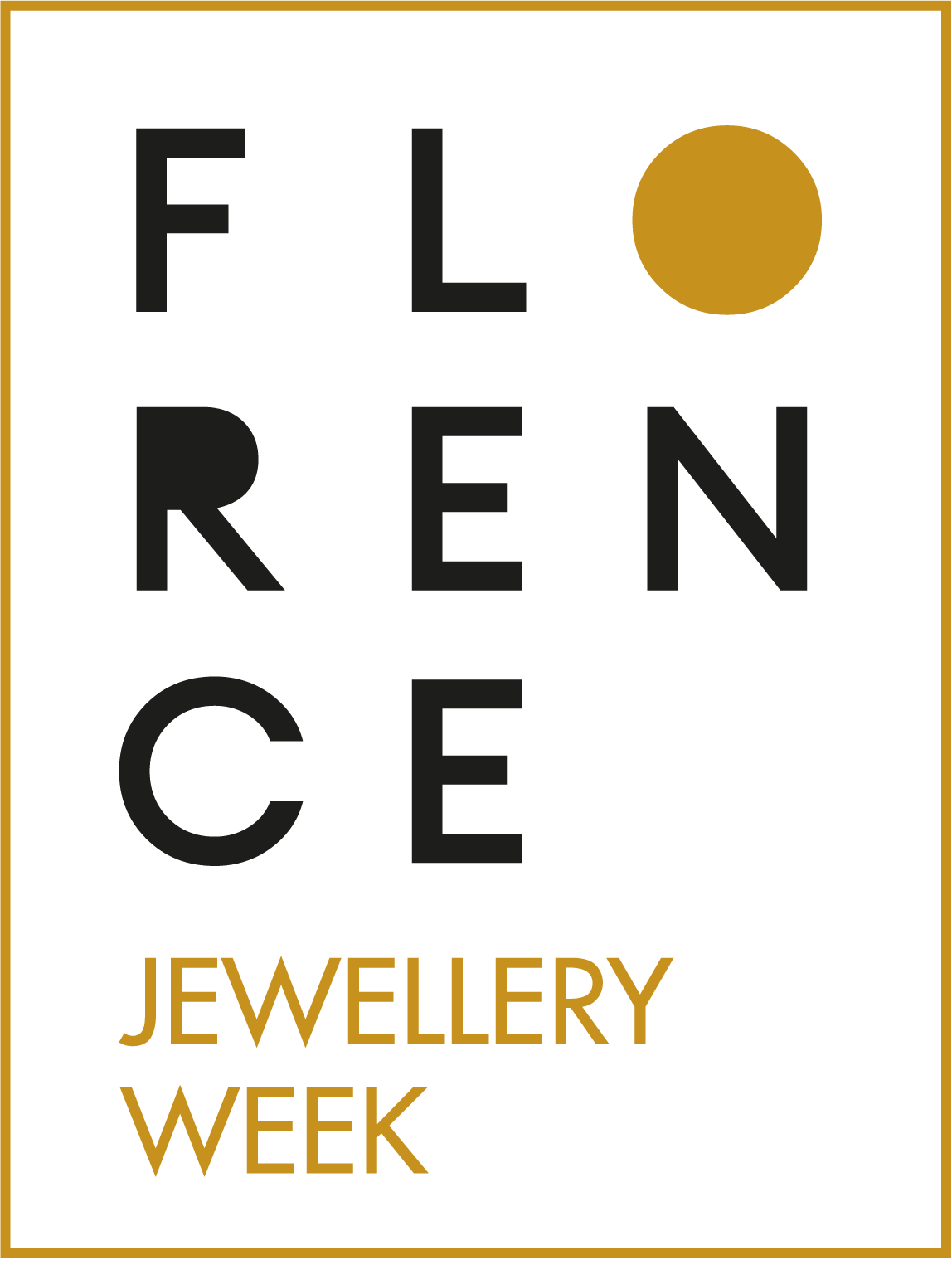The 15th edition of Pensieri Preziosi, hosted as usual at the San Rocco Oratory in Padua and curated by Mirella Cisotto Nalon, shows from 30.11.2019 to 16.02.2020 the Bollmann Collection, the most prestigious European private collection of contemporary jewellery. Over a thousand pieces realised by the most influential masters who have determined the course of the “New Jewellery” since the 50s to the present day. About 100 ornaments selected for the exhibition crystallises almost 60 years of passion for the jewellery of research, retracing the collecting choices of the Austrian couple Karl and Heidi Bollmann.
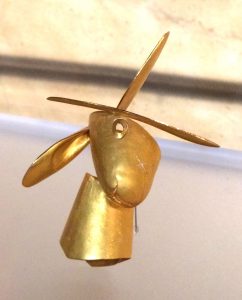
Manfred Bischoff, Unzucht / Badly grown, brooch, 2004, gold.

Bruno Martinazzi, Fileo, ring, 1996, yellow gold.
The opening of the exhibition was preceded by the presentation of the catalog, during which the wife Heidi intervened. Sitting among the audience, I listened her telling with irony and emotion amusing anecdotes related to her “precious” pieces. She recounted about moments spent together with the most attached artists, like Bruno Martinazzi and Manfred Bischoff, or Renzo Pasquale and Annamaria Zanella, who took part for the occasion. His words made me think of the diligent passion that hides behind the patient feeling of the collector, who acts, quoting Marco Belpoliti, as “a child who has learned the difficult art of living in the things he has collected, without end”*. Even more, here the passion is doubly nourished, by the sharing of love for art, by the elective affinities that cement over time a couple relationship.
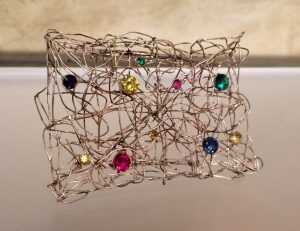
Jürgen Eickhoff, Disturbare la geometria, 2016, brooch, silver wire.
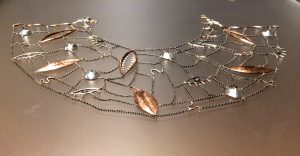
Ulrike Johannssen, Necklace, 1987, silver, copper, opals.
The episode that gave the start to this vast collection was the search for a gift from Karl Bollmann to his wife, for the arrival of the second son. Karl was looking for a jewel, unique not only in its workmanship, but above all original in its ideation. Happily surprised by the genius of Peter Skubič during a collective exhibition at the MAK Museum of Applied Arts in Vienna in which the jeweler participated in, Mr. Bollmann decided to commission him the special present. Karl provided him the stones, diamonds he had inherited, which should have given luster to the jewel… But the artist instead acted in total freedom and created a kinetic ring made of steel! It could be said that precisely Skubic’s freedom laid the foundations of the collection; freedom that Karl defines in the catalog as the true essence of art.
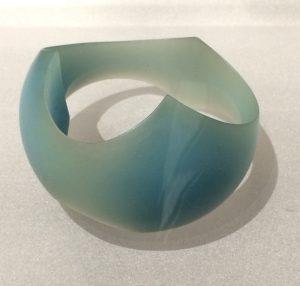
Gijs Bakker, Shot, Bracelet, 1996, plastic, polyester.
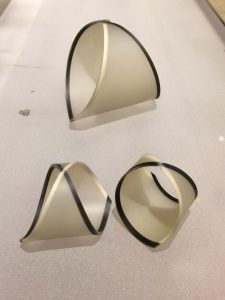
Emmy Van Leersum, Bracelet, Earrings, 1982, plastic, plexiglas.
The work of art, when it takes the shape of the jewel, clarifies Mr. Bollmann, “must be new, and yet timeless, free and bound in matter, made by a certain person, assignable to him and then universally valid, move along with the movements of the wearer, even strengthen their resulting effects, but at the same time it must be a sign of clarity, balance and calmness”**. The assumption of the jewel’s wearability is an essential criterion that has guided the collection of these jewels. Heidi underlined the urgency of wearing contemporary jewelry, since artists need it and we need it most of all to better understand our present and to take part in it consciously. His words reminded me of those of Mauro Falciani, who, in a completely different context, wrote: “I read contemporaries because I am a contemporary too, when I’ll be a classic, then I’ll also read the classics”***.

Kazumi Nagano, Bracelet, 2006, gold wire, woven rice paper.
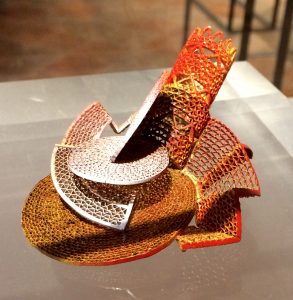
Robert Baines, Pendant, 2007, metal wire, lacquer, silver.
We must keep in mind that when we wear a jewel made by an artist we transform ourselves into active supporters and public promoters of his interpretation of jewellery, which is always in strong relation with the culture of its time, meant as an historical moment of specific transformations in progress. Once again, Mirella Cisotto recalls in the catalog that when we wear art jewellery, we allow art, and therefore beauty, to break in and reshape our everyday life.
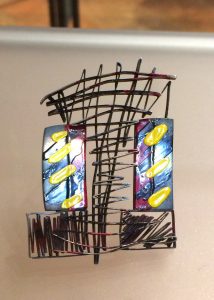
Joaquim Capdevila, Brooch, 1986, burnished silver, lacquer.
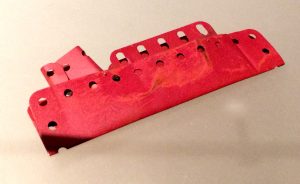
Annamaria Zanella, Red ship / Nave Rossa, brooch, 2018, metal components.
Another requirement that the ornaments chosen by Karl and Heidi Bollmann must have is the ability to last over time. “The object – explains Karl – should be contemporary, but it should also endure and embody the possibility of having comfort and security”****.
Finally, this incredible collection is the laudable attempt to preserve the tangible testimony of the creative fantasy from the oblivion of time. In the showcases displayed among the frescoed walls of the Oratory, this aim takes the measurable and eternal shape of the jewel.
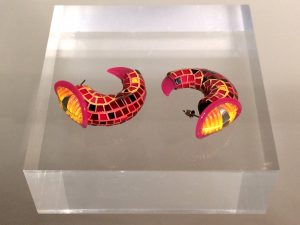
Peter Chang, Hole Earrings, 1991, plastic.
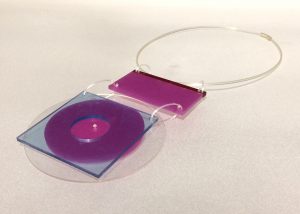
Hermann Jünger, Pendant, 1970, plexiglas.
* Marco Belpoliti, Colleziona, colleziona, qualcosa resterà, in “La Stampa”, 2015.
** Karl Bollmann, Face-to-face with Karl Bollmann – Interviewed by Mirella Cisotto Nalon, in Pensieri Preziosi. Bollmann Collection. Contemporary Jewellery 1960-2018, catalog of the exhibition (Padova, Oratorio di San Rocco, November 30 2019 – February 16 2020) curated by Mirella Cisotto Nalon, Padova, 2019, p. 47.
*** Mauro Falciani was the owner of “StileLibero”, an independent bookshop that for some years has been a reference for the cultural life of Foggia.
**** K. Bollmann, 2019, p. 46.
